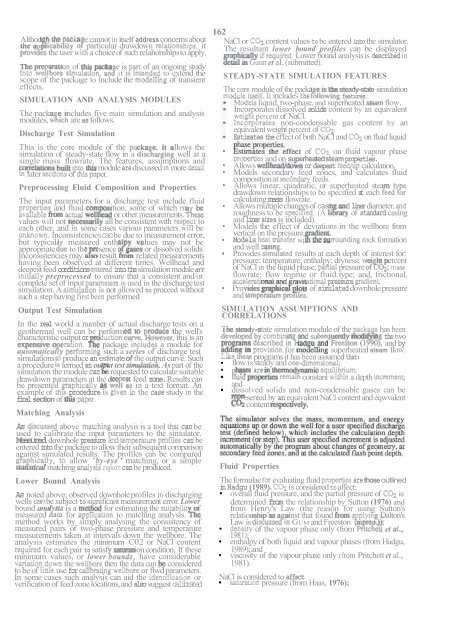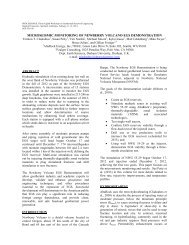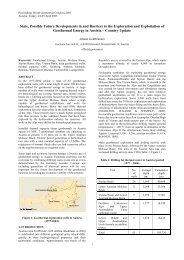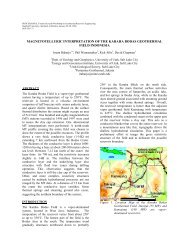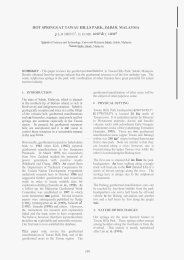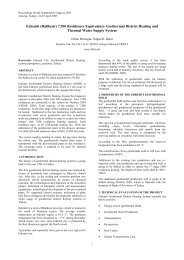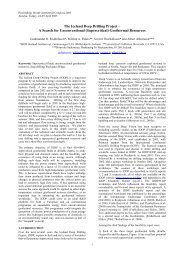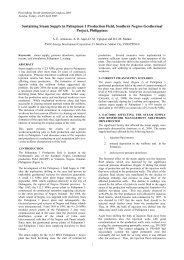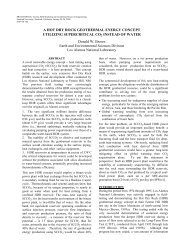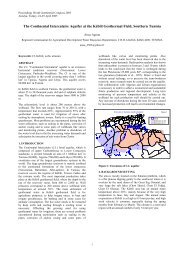an integrated steady-state - International Geothermal Association
an integrated steady-state - International Geothermal Association
an integrated steady-state - International Geothermal Association
You also want an ePaper? Increase the reach of your titles
YUMPU automatically turns print PDFs into web optimized ePapers that Google loves.
162<br />
Although the e c<strong>an</strong>not in itself address concerns about NaCl or content values to be entered into the simulator.<br />
the a particular drawdown it<br />
the user with a choiceof such relahonshipsto apply.<br />
The result<strong>an</strong>t lower bound profiles c<strong>an</strong> be displayed<br />
Lower bound <strong>an</strong>alysisis described in<br />
Gunn et al. (submitted).<br />
pre of e is of <strong>an</strong> ongoing study<br />
it is to extend the<br />
scope of the package to include the of tr<strong>an</strong>sient<br />
STEADY-STATE SIMULATION FEATURES<br />
effects.<br />
The module of the packa e is the <strong>steady</strong>-<strong>state</strong> simulation<br />
SIMULATION AND ANALYSIS MODULES<br />
includes the<br />
features.<br />
liquid, two-phase, <strong>an</strong>d superheated steam flow.<br />
The packa e includes five main simulation <strong>an</strong>d <strong>an</strong>alysis<br />
Incorporates dissolved solids content by <strong>an</strong> equivalent<br />
modules, are as follows.<br />
percent of NaCl.<br />
non-condensable gas content by <strong>an</strong><br />
Discharge Test Simulation<br />
This is the core module of the packa e. It allows the<br />
simulation of <strong>steady</strong>-<strong>state</strong> flow in a well at a<br />
single mass flowrate, The features, assumptions <strong>an</strong>d<br />
module are discussed more<br />
later of paper.<br />
Preprocessing Fluid Composition <strong>an</strong>d Properties<br />
The input parameters for a discharge test include fluid<br />
<strong>an</strong>d fluid sition, some of which ma be<br />
or other measurements.<br />
values will not all be consistent with to<br />
each other, <strong>an</strong>d in some cases various parameters will be<br />
Inconsistenciesc<strong>an</strong> be due to measurement error,<br />
but typical1 measured enthal y values may not be<br />
appropriate to the resence or dissolved solids.<br />
Inconsistencies may result related measurements<br />
having been observed at different times. Wellhead <strong>an</strong>d<br />
deepestfeed conditions into the simulationmodule are<br />
preprocessed to ensure that a consistent <strong>an</strong>d/or<br />
complete set of input is used in the discharge test<br />
simulation. A is not allowed to proceed without<br />
such a step having first been performed<br />
Output Test Simulation<br />
In the real world a number of actual discharge tests on a<br />
geothermal well c<strong>an</strong> be performed to the well's<br />
characteristic output or<br />
this is <strong>an</strong><br />
expensive o package a module for<br />
such a series of discharge test<br />
simulations produce <strong>an</strong> estimateof the output curve. Such<br />
a procedure termed <strong>an</strong> out ut test As part of the<br />
simulation the module c<strong>an</strong> requested to calculate suitable<br />
drawdown parameters at the dee feed zone.Results c<strong>an</strong><br />
be presented<br />
in a text format. An<br />
example of procedure is the case study in the<br />
final section of<br />
Matching Analysis<br />
As above <strong>an</strong>alysis is a tool c<strong>an</strong> be<br />
used to calibrate the mput parameters to the simulator.<br />
Measured downhole pressure <strong>an</strong>d<br />
c<strong>an</strong> be<br />
entered into the package to allow their subsequent comparison<br />
against simulated results. The profiles c<strong>an</strong> be compared<br />
allow ' matching, or a simple<br />
matchmg report c<strong>an</strong> be produced.<br />
Lower Bound Analysis<br />
As noted above, observed downholeprofiles in discharging<br />
wells c<strong>an</strong> be subject to signific<strong>an</strong>t measurement error.Lower<br />
bound <strong>an</strong>al is a for estimating the of<br />
measured for to matching <strong>an</strong>alysis.<br />
method works by simply <strong>an</strong>alysing the consistency of<br />
measured pairs of two-phase pressure <strong>an</strong>d temperature<br />
measurements taken at intervals down the wellbore. The<br />
<strong>an</strong>alysis estimates the minimum C02 or NaCl content<br />
for each pair to satisf saturation condition, If these<br />
minimum values, or lower have considerable<br />
the then the data c<strong>an</strong> considered<br />
to be of use for or flwd parameters.<br />
In some cases such <strong>an</strong>alysis c<strong>an</strong> aid the<br />
or<br />
verification of feed zone locations, <strong>an</strong>d also suggest calibrated<br />
equivalentweight percent of<br />
Estimates the effectof both NaCl <strong>an</strong>d<br />
on fluid liquid<br />
of on fluid vapour phase<br />
<strong>an</strong>d on superheatedsteam properties.<br />
Allows or deepest calculation.<br />
Models secondary feed zones, <strong>an</strong>d calculates fluid<br />
compositionat feeds.<br />
Allows linear, quadratic, or superheated steam<br />
drawdown relationshipsto be specified at each<br />
calculating mass flowrate.<br />
Allows multiplech<strong>an</strong>gesof casin <strong>an</strong>d liner diameter,<br />
roughness to be (A of st<strong>an</strong>dard casing<br />
<strong>an</strong>d liner sizes is included).<br />
Models the effect of deviations in the wellbore from<br />
vertical on the pressure,<br />
Models the rock formation<br />
<strong>an</strong>d well<br />
Provides results at each depth of interest for:<br />
pressure; temperature; enthalpy; dryness; wei ht percent<br />
of NaCl the liquid phase; pressure<br />
flowrate; flow regime or fluid.type; <strong>an</strong>d, frictional,<br />
<strong>an</strong>d<br />
pressure<br />
Provides<br />
of simulated downhole pressure<br />
<strong>an</strong>d<br />
SIMULATION ASSUMPTIONS AND<br />
CORRELATIONS<br />
The stead -<strong>state</strong> simulation module of the has been<br />
<strong>an</strong>d su uently the two<br />
<strong>an</strong>d by<br />
ad n for superheated steam flow.<br />
programsit has been assumed that:<br />
flow is <strong>steady</strong> <strong>an</strong>d<br />
are<br />
const<strong>an</strong>t a depth<br />
<strong>an</strong>d<br />
dissolved solids <strong>an</strong>d non-condensable gases c<strong>an</strong> be<br />
resented by <strong>an</strong> equivalent NaCl content <strong>an</strong>d eqwvalent<br />
C content<br />
Fluid Properties<br />
The formulae evaluating fluid are those outlined<br />
in Hadgu (1989). is considered toaffect:<br />
overall fluid pressure, <strong>an</strong>d the partial pressure of is<br />
determined from the relationship by Sutton (1976) <strong>an</strong>d<br />
from Henry's Law (the reason for using Sutton's<br />
relationship as a ainst that found<br />
Dalton's<br />
Law is GUM <strong>an</strong>d Freeston (m<br />
of the vapour phase only (from et<br />
enthalpy of both liquid <strong>an</strong>d vapour phases (from Hadgu,<br />
1989);<strong>an</strong>d<br />
viscosity of the vapour phase only (from Pritchett et al.,<br />
1981).<br />
NaCl is considered to affect<br />
pressure (from Haas, 1976);


